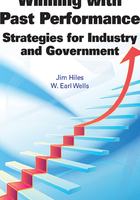
Chapter 3 PAST PERFORMANCE AS STORYTELLING
A government solicitation always provides specific instructions regarding the past performance information it requires from an offeror. Generally speaking, it details requirements for factual data about the offeror’s past performance on a contract, including such data as the scope of services, period of performance, dollar value, type of contract, and a variety of other factors. Solicitations also allow varying degrees of flexibility in the “write-up” describing how the work an offeror has performed in the past has impacted its clients and delivered results. The best way for an offeror to showcase its past performance in write-ups is to lay out a compelling story that affirms a contractor’s expertise and its commitment to a past project. This narrative will reinforce the impression given by the data that contract award to the offeror is low risk, that the offeror is reliable, and that its past performance is highly relevant to the current project.
Contractors need to adopt a methodical approach to the past performance write-up that helps them develop a compelling story about their experience and qualifications to perform at a high level for a project on which they plan to bid. We describe such an approach in this chapter. As a best practice, managing past performance information is a continuous process that begins with a contract award and carries through to documenting a firm’s performance at various levels of detail in the project. It continues on to the presentation of that information—how it describes its role in the project—when it is placing offers on new solicitations. Past performance as storytelling means creating stories that represent an honest and thorough evaluation of the skills that a company can bring to any prospective, relevant project.
The most important consideration in creating a best-practice past performance write-up is the characteristics and nature of the evaluators, who each have their own information needs. Many people will read a write-up—the contracting officer, a government program manager, and other technical managers or specialists as needed, forming the proposal review team. The offeror must understand who they are and meet each individual’s needs; it should not use cookie-cutter proposals or past performance write-ups, but should instead tailor its write-up to enhance its position as the offeror to select on a particular solicitation.
When a company creates a past performance write-up, it should follow four steps or phases to produce a story that the proposal review team can understand and, more importantly, that effectively identifies the contractor with the story in a way that clearly establishes it as the best choice for the (similar) pending project:
1. Providing just the facts
2. Providing context
3. Providing impact
4. Increasing understanding.
These steps are highly effective tools for developing a past performance write-up for an ongoing project that will become a source of past performance information for future proposals. Everyone engaged in the project should contribute to the development of the past performance write-up, and the project manager should add items as they arise. Each step performs a specific function in convincing evaluators of a firm’s ability to effectively manage the project being bid on. As the story of past performance experiences is built, its message of delivering above and beyond the client’s requirements should increase the evaluation team’s confidence in the firm, leading to a low risk rating and possibly a positive recommendation for award. Each level also serves a specific purpose in describing the firm’s past work as it relates to a new solicitation’s performance work statement (PWS).
Fictional examples provide a visual accompaniment to the discussion to aid in understanding each step as well as how an evaluation team may view the information. These exhibits present the steps as layers or dimensions that can and should be added to a company’s past performance information as it is developed, from contract award through proposal development for the next offer.